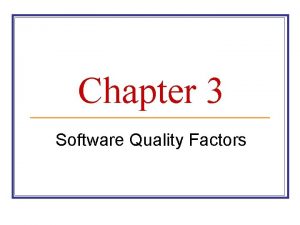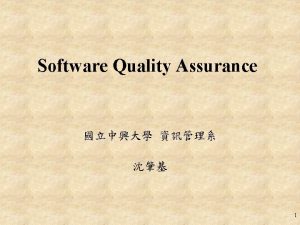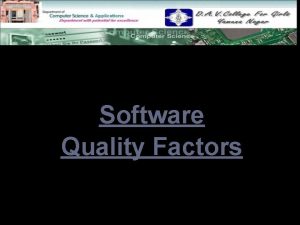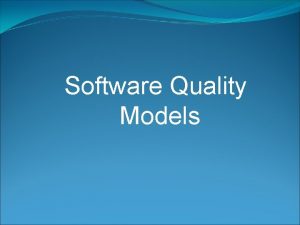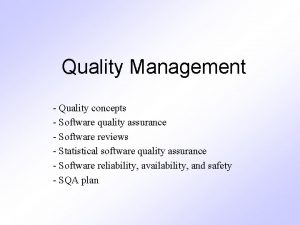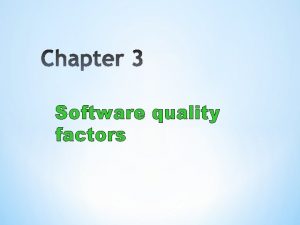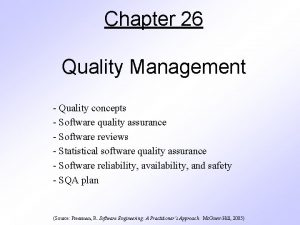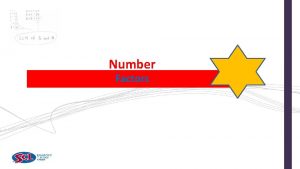Chapter 3 Software Quality Factors The need for














































- Slides: 46

Chapter 3 Software Quality Factors

The need for comprehensive software quality requirements n n Our Sales IS seems v. good , but it is frequently fails, at least twice a day for 20 minutes or more. ( SW house claims no responsibility…. Local product contains a SW and every thing is ok, but, when we began planning the development of a European version, almost all the design and programming will be new.

The need for comprehensive software quality requirements There are some characteristic common to all these “but’s”: ■ All the software projects satisfactorily fulfilled the basic requirements for correct calculations (correct inventory figures, correct average class’s score, correct loan interest, etc. ). ■ All the software projects suffered from poor performance in important areas such as maintenance, reliability, software reuse, or training. ■ The cause for the poor performance of the developed software projects in these areas was the lack of predefined requirements to cover these important aspects of the software’s functionality. The requirements document is one of the most important elements for achieving software quality n

The need for comprehensive software quality requirements n There is a need for a comprehensive definition of requirements that will cover all attributes of software and aspects of the use of software, including usability aspects, reusability aspects, maintainability aspects, and so forth in order to assure the full satisfaction of the users.

Quality factors The great variety of issues related to the various attributes of software and its use and maintenance, as defined in software requirements documents, can be classified into groups called quality factors. n The team responsible for defining the software requirements of a software system is expected to examine the need to define the requirements that belong to each factor

Classification of software requirements into software quality factors. Mc. Call’s factor model classifies all software requirements into 11 software quality factors. The 11 factors are grouped into three categories as follows: 1 - Products operation factors: (daily operation of the software) Correctness, Reliability, Efficiency, Integrity, Usability. 2 - Product revision factors: (maintenance activates) Maintainability, Flexibility, Testability. 3 - Product transition factors: (software adaptation to other environments and it’s interaction with other software systems) Portability, Reusability, Interoperability.


Product operation software quality factors Deals with requirements that directly affect the daily operation of the software. Correctness: n Correctness requirements are defined in a list of the software system’s required outputs n How many errors there are in the software?

Correctness Output specifications are usually multidimensional; some common dimensions include: n n n The output mission (e. g. , sales invoice printout, and red alarms when temperature rises above 250°F). The required accuracy of those outputs that can be adversely affected by inaccurate data or inaccurate calculations. The completeness of the output information, which can be adversely affected by incomplete data. The up-to-dateness of the information (defined as the time between the event and its consideration by the software system). The availability of the information (the reaction time, defined as the time needed to obtain the requested information or as the requested reaction time).

Correctness Example (club membership info system) n n n 1. Output mission: list of 11 reports, 4 standard letters, 3 interactive queries. 2. Required accuracy: prob of a non-accurate output <1%. 3. Completeness: prob of missing data about a member, attendance, payments etc < 1%. 4. Up-to-dateness: no more than 2 days for info about event participation to be valid 5. Availability: reaction time to queries < 2 seconds, to reports < 4 hours

Product operation software quality factors n Reliability: Reliability requirements deal with failures to provide services. They determine the maximum allowed SW system failure rate, and can refer to entire system or one of its function. E. g. The failure frequency of a heart-monitoring unit that will operate in a hospital’s intensive care ward is required to be less than one in 20 years. Its heart attack detection function is required to have a failure rate of less than one per million cases.

Product operation software quality factors Efficiency: Efficiency requirements deal with the hardware resources needed to perform all the functions of the software system in conformance to all other requirements. Ex. n Processing power (MIPS, MHz) n Storage capacity (GBytes, TBytes) n Data communication capabilities (MBPS, GBPS)

Product operation software quality factors Integrity: Integrity requirements deal with the software system security. That is requirements to prevent unauthorized access. Ex. “read only” permit

Product operation software quality factors Usability: Usability requirements deal with the scope of staff needed to train a new employee and to operate the software system. n Eg Help Desk requirements § Two days to train new staff § One staff to handle 60 calls per day n

Product revision software quality factors: Deal with those requirements that affect the complete range of software maintenance activities: n Corrective maintenance: correction of software faults and failures. Adaptive maintenance: adapting the current software to additional circumstances and customers without changing the software. Perfective maintenance: enhancement and improvement of existing software with respect to locally limited issues.

Product revision software quality factors: The three quality factors comprise the product revision category are: Maintainability requirements determine the efforts that will be needed by users and maintenance personnel to identify the reasons for software failures, to correct the failures, and to verify the success of the corrections.

Product revision software quality factors: This factor’s requirements refer to 1 - The modular structure of software 2 - The internal program documentation 3 - The programmer’s manual. Examples: a- The size of a software module will not exceed 30 statements b- The programmer will adhere to the company coding standards and guidelines.

Product revision software quality factors: Flexibility: The capabilities and efforts required to support adaptive maintenance activities are covered by the flexibility requirements. n These include the resources (in man-days) required to adopt a software to a varieties of customers of the same trade and of various extents of activities.

Product revision software quality factors: The flexibility requirements also support perfective maintenance activities, such as changes and additions to the software in order to improve its service and to adapt it to changes in the technical or commercial environment.

Product revision software quality factors: As example TSS (teacher support SW. ) calculation of final grades, pupil achievements…etc The SW specifications of TSS include the following flexibility requirements: a) The SW should be suitable for all teachers of all subjects and all school levels b) Non-professionals should be able to create new types of reports according to schoolteacher’s requirements. n

Product revision software quality factors: Testability requirements deal with the testing of an information system as well as with its operation. n Testability requirements for the ease of testing are related to special features in the programs that help the tester, for instance by providing predefined immediate results and log files. n Testability requirements related to software operation include automatic diagnostics performed by the software system prior to starting the system, to find out whether all components of the software system are in working order and to obtain a report about the detected faults.

Product revision software quality factors: Example An industrial computerized control unit is programmed to calculate various measures of production status, report the performance level of the machinery, and operate a warning signal in predefined situations. One testability requirement demanded was to develop a set of standard test data with known system expected correct reactions in each stage. This standard test data is to be run every morning, before production begins, to check whether the computerized unit reacts properly. n

Product Transition software quality factors: Factors that deals with the adaptation of software to other environments and it’s interaction with other software systems Portability: Portability requirements tend to the adaptation of a software system to other environments consisting of different hardware, different operating systems, and so forth. It make possible to use the software in different SW and HW simultaneously. Example : A software package which designed and programmed to operate in a Windows 7 environment is required to allow lowcost transfer to Linux and Windows NT environments.

Product Transition software quality factors: Reusability requirements deal with the use of software modules originally designed for one project in a new software project currently being developed. n The reuse of SW is expected to save development resources, shorten the development period and provide higher quality modules. These benefits based on the assumption that the most of the SW faults have already been detected and solved

Product Transition software quality factors: Interoperability requirements focus on creating interfaces with other software systems or with other equipment firmware. Interoperability requirements can specify the names of the software or firmware for which interface is required. The can also specify the output structure accepted as standard in a specific industry or applications area. n Example: The firmware of a medical laboratory’s equipment is required to process its results (output) according to a standard data structure that can then serve as input for a number of standard laboratory information systems.

Alternative models of software quality factors: Two factor models, appearing during late 1988 s, considered to be alternatives to Mccall classic factor model: 1 -The Evans and Marciniak factor model 1987. 2 -The Deutsh and Willis factor model 1988. A formal comparison of the factor models reveals: ■ Both alternative models exclude only one of Mc. Call’s 11 factors, namely the testability factor. ■ The Evans and Marciniak factor model consists of 12 factors that are classified into three categories. ■ The Deutsch and Willis factor model consists of 15 factors that are classified into four categories

Alternative models of software quality factors: Five new factors were suggested by the two alternative factor models: 1 -Verifiability. (by both) 2 - Expandability. (by both) 3 - Safety. (by Deutsh and willis) 4 - Manageability. (by Deutsh and willis) 5 - Survivability. (by Deutsh and willis)

Alternative models of software quality factors: Verifiability requirements define design and programming features that enable efficient verification of the design and programming. Most verifiability requirements refer to modularity, to simplicity, and to adherence to documentation and programming guideline.

Alternative models of software quality factors: Expandability requirements refer to future efforts that will be needed to serve large populations, improve service, or add new applications in order to improve usability. n The majority of these requirements are covered by Mc. Call`s flexibility factor.

Alternative models of software quality factors: Safety requirements are meant to eliminate conditions dangerous to operators of equipment as a result of errors in process control software. These errors can result in inappropriate reactions to dangerous situations or to the failure to provide alarm signals when the dangerous conditions to be detected by the software arise.

Alternative models of software quality factors: n n n Safety Example In a chemical plant, a computerized system controls the flow of acid according to pressure and temperature changes occurring during production. The safety requirements refer to the system’s computerized reactions in cases of dangerous situations and also specify what kinds of alarms are needed in each case.

Alternative models of software quality factors: Manageability requirements refer to the administrative tools that support software modification during the software development and maintenance periods, such as configuration management, software change procedures. Example : “Chemilog” is a software system that automatically logs the flows of chemicals into various containers to allow for later analysis of the efficiency of production units. The development and issue of new versions and releases of “Chemilog” are controlled by the Software Development Board, whose members act according to the company’s software modifications procedure.

Alternative models of software quality factors: Survivability requirements refer to the continuity of service. Defined as: - the minimum time allowed between failures of the system - the maximum time permitted for recovery of service, two factors that pertain to service continuity.

Alternative models of software quality factors: By comparing the contents of the factor models we fined that: - Expandability and Survivability actually resemble Flexibility and Reliability. - Testability can be considered as one element in Maintainability factor. Therefore the alternative factor models add only three new factors to Mc. Call`s model : Verifiability, Safety, and Manageability.

Structure of the alternative factor models

Who is interested in the definition of quality requirements? 1 - The client: The requirements document he prepares does indeed serve as a fundamental protection against low quality 2 - The software developer: add requirements represent his own interest.

Who is interested in the definition of quality requirements? Examples: (1) Reusability requirements. In cases where the client anticipates development in near future of an additional software system having strong similarities to the present software, the client will himself initiate reusability requirements. In other cases, the client is interested in reusing parts of software systems that were developed earlier in a new system.

Who is interested in the definition of quality requirements? The developer, who serves a great variety of clients, will recognize the potential benefits of reuse, and will enter reusability into the list of requirements to be fulfilled by the project team.

Who is interested in the definition of quality requirements? (2) Verifiability requirements. These requirements are meant to improve the design reviews and software tests carried out during software development. Their aim is to save development resources and they are, therefore, of interest to developers. The client, however, is usually uninterested in placing requirements that deal with the internal activities of the developer team.

Who is interested in the definition of quality requirements? The following list of quality factors usually interest the developer whereas they may raise very little interest on the part of the client: 1 - Portability 2 - Reusability 3 - Verifiability.

Who is interested in the definition of quality requirements? So, The project might be carried out according to two requirements documents: 1 - the client's requirements document 2 - The developer's additional requirements document.

Software compliance with quality factors n Throughout the software development process, the extent to which the process complies with the requirements of the various quality factors is examined by design reviews, software inspections, software tests, and so forth.



Example n The software requirement document for the tender for development of “Super-lab, ” a software system for managing a hospital laboratory, consists of chapters according to the required quality factors as follows: correctness, reliability, efficiency, integrity, usability, maintainability, flexibility, testability, portability, reusability and interoperability

No. Section taken from the software requirement document 1 The probability that the “Super-lab” software system will be found in a state of failure during peak hours (9 am to 4 pm) is required to be below 0. 5%. 2 The “Super-lab” software system will enable direct transfer of laboratory results to those files of hospitalized patients managed by the “MD-File” software package. 3 The “Super-lab” software system will include a module that prepares a detailed report of the patient ’s laboratory test results during his current hospitalization. (This report will serve as an appendix to the family physician’s file. ) The time required to obtain this printed report will be less than 60 seconds; the level of accuracy and completeness will be at least 99%. 4 The “Super-lab” software to be developed for hospital laboratory use may be adapted later for private laboratory use. 5 The training of a laboratory technician, requiring no more than 3 days, will enable the technician to reach level C of “Super-lab” software usage. This means that he or she will be able to manage reception of 20 patients per hour. 6 The “Super-lab” software system will record a detailed users’ log. In addition, the system will report attempts by unauthorized persons to obtain medical information from the laboratory test results database. The report will include the following information: the network identification of the applying terminal, the system code of the employee who requested that information, the day and time of attempt and the type of attempt. 7 The “Super-lab” subsystem that deals with billing patients for their tests may be eventually used as a subsystem in the “Physiotherapy Center” software package. 8 The “Super-lab” software system will process all the monthly reports for the hospital departments’ management, the hospital management, and the hospital controller according to development contract. 9 The software system should be able to serve 12 workstations and 8 automatic testing machines with a single model AS 20 server and a CS 25 communication server that will be able to serve 25 communication lines. This hardware system should conform to all availability requirements listed in development contract. 10 The “Super-lab” software package developed for the Linux operating system should be compatible for applications in a Windows NT environment. The requirements factor
 Which quality factor comes in product revision category?
Which quality factor comes in product revision category? Software quality factors ppt
Software quality factors ppt Computer software assurance
Computer software assurance Importance of food quality
Importance of food quality Quality assurance vs quality control
Quality assurance vs quality control Plan quality management pmp
Plan quality management pmp Pmbok quality management
Pmbok quality management Process of nursing audit
Process of nursing audit Quality improvement vs quality assurance
Quality improvement vs quality assurance Basic concepts of quality control
Basic concepts of quality control David a garvin 8 dimensions of quality
David a garvin 8 dimensions of quality Quality is free
Quality is free What is tqm
What is tqm Kontinuitetshantering i praktiken
Kontinuitetshantering i praktiken Typiska novell drag
Typiska novell drag Tack för att ni lyssnade bild
Tack för att ni lyssnade bild Ekologiskt fotavtryck
Ekologiskt fotavtryck Varför kallas perioden 1918-1939 för mellankrigstiden
Varför kallas perioden 1918-1939 för mellankrigstiden En lathund för arbete med kontinuitetshantering
En lathund för arbete med kontinuitetshantering Underlag för särskild löneskatt på pensionskostnader
Underlag för särskild löneskatt på pensionskostnader Tidböcker
Tidböcker Sura för anatom
Sura för anatom Densitet vatten
Densitet vatten Datorkunskap för nybörjare
Datorkunskap för nybörjare Boverket ka
Boverket ka Att skriva debattartikel
Att skriva debattartikel För och nackdelar med firo
För och nackdelar med firo Nyckelkompetenser för livslångt lärande
Nyckelkompetenser för livslångt lärande Påbyggnader för flakfordon
Påbyggnader för flakfordon Vätsketryck formel
Vätsketryck formel Svenskt ramverk för digital samverkan
Svenskt ramverk för digital samverkan Jag har nigit för nymånens skära text
Jag har nigit för nymånens skära text Presentera för publik crossboss
Presentera för publik crossboss Jiddisch
Jiddisch Vem räknas som jude
Vem räknas som jude Klassificeringsstruktur för kommunala verksamheter
Klassificeringsstruktur för kommunala verksamheter Mjälthilus
Mjälthilus Bästa kameran för astrofoto
Bästa kameran för astrofoto Cks
Cks Lågenergihus nyproduktion
Lågenergihus nyproduktion Mat för unga idrottare
Mat för unga idrottare Verktyg för automatisering av utbetalningar
Verktyg för automatisering av utbetalningar Rutin för avvikelsehantering
Rutin för avvikelsehantering Smärtskolan kunskap för livet
Smärtskolan kunskap för livet Ministerstyre för och nackdelar
Ministerstyre för och nackdelar Tack för att ni har lyssnat
Tack för att ni har lyssnat Referat mall
Referat mall
